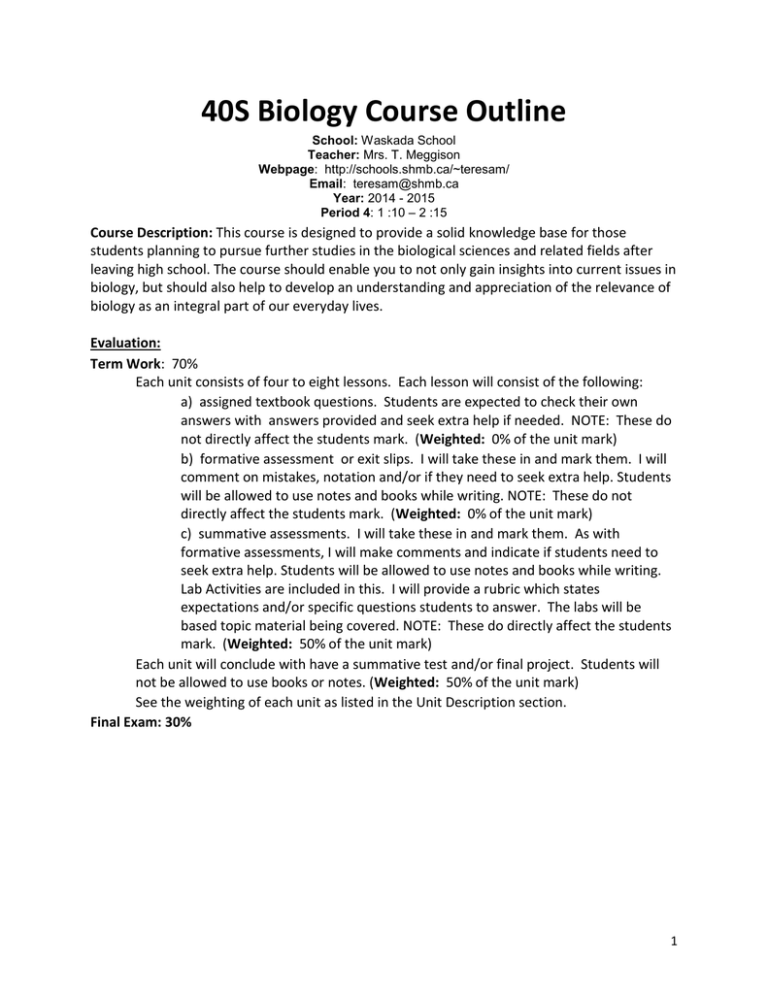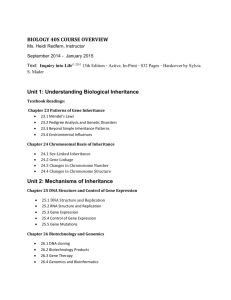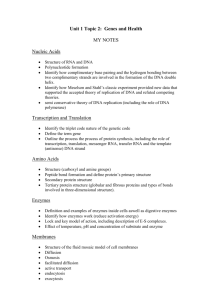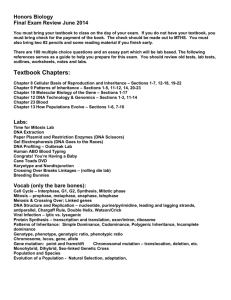40S Biology Course Outline 2014 2015
advertisement

40S Biology Course Outline School: Waskada School Teacher: Mrs. T. Meggison Webpage: http://schools.shmb.ca/~teresam/ Email: teresam@shmb.ca Year: 2014 - 2015 Period 4: 1 :10 – 2 :15 Course Description: This course is designed to provide a solid knowledge base for those students planning to pursue further studies in the biological sciences and related fields after leaving high school. The course should enable you to not only gain insights into current issues in biology, but should also help to develop an understanding and appreciation of the relevance of biology as an integral part of our everyday lives. Evaluation: Term Work: 70% Each unit consists of four to eight lessons. Each lesson will consist of the following: a) assigned textbook questions. Students are expected to check their own answers with answers provided and seek extra help if needed. NOTE: These do not directly affect the students mark. (Weighted: 0% of the unit mark) b) formative assessment or exit slips. I will take these in and mark them. I will comment on mistakes, notation and/or if they need to seek extra help. Students will be allowed to use notes and books while writing. NOTE: These do not directly affect the students mark. (Weighted: 0% of the unit mark) c) summative assessments. I will take these in and mark them. As with formative assessments, I will make comments and indicate if students need to seek extra help. Students will be allowed to use notes and books while writing. Lab Activities are included in this. I will provide a rubric which states expectations and/or specific questions students to answer. The labs will be based topic material being covered. NOTE: These do directly affect the students mark. (Weighted: 50% of the unit mark) Each unit will conclude with have a summative test and/or final project. Students will not be allowed to use books or notes. (Weighted: 50% of the unit mark) See the weighting of each unit as listed in the Unit Description section. Final Exam: 30% 1 Course Outline: Unit 1 – Genetics Tentative Time Line Feb. 2 to Feb. 17 Tentative Unit Test Dates Feb. 17 Unit 2 – Human Genetics Feb. 18 to March 5 March 5 Unit 3 – Genetic Engineering March 6 to March 19 March 19 Unit 4 – Molecular Basis for Inheritance March 20 to April 14 April 14 Unit 5 – Biodiversity + Unit 6 – Accounting for Diversity April 15 to April 28 April 28 Unit 7 – Evolution: Theory and Processes April 29 to May 11 May 11 Unit 8 – Viruses, Monerans, Protists, and Fungi May 12 to May 25 May 25 Unit 9 - The Plant Kingdom May 26 to June 2 June 2 Unit 10 – The Animal Kingdom June 3 to June 11 June 11 Course Materials: Pen, pencil and eraser Graph paper Scientific or graphing calculator Geometry set (compass and protractor) Binder Ruler Loose leaf ABSOLUTELY NO CELL PHONES IN CLASS!! If you have one, for your sake and mine, please leave it in your locker or have it turned off. If caught using a phone, I’ll take it away and your parents will have to come pick it up. It is not an acceptable substitute for a calculator. IPODS - You are not allowed to have ear buds in during instruction time or group discussion and work. Again, IPODS are not an acceptable substitute for a calculator. 2 Statement of Standards – Students Completion of Course Evaluation Requirements In accordance with the Waskada School Policy on student assessment, evaluation, and reporting, the following apply: Late assignments will be deducted 10% for the first day late and 20% for the second day late. A zero grade is given to any assignment more than two days late. Any extension for a student to the above standard will only be considered by the administration when requested by the teacher. Unexplained absences during test or assignments dates will result in a grade of zero. If a student is absent and it is explained, work covered will be posted on my webpage. It is the responsibility of the student to refer to this to catch up on work and assignments missed. Extra Help: Extra help is available and should be sought on an as needed basis. I am available almost every noon hour and Day 1 first period. Unit Descriptions 1st Half of semester Topic 1: Understanding Biological inheritance Unit 1: Genetics approx. 11 classes (13%) Timeline: Feb. 2 to Feb. 17 Specific learning outcomes - Outline Gregor Mendel’s principles of inheritance, stating their importance to the understanding of heredity. Include: principles of segregation, dominance, and independent assortment - Explain what is meant by the terms heterozygous and homozygous. - Distinguish between genotype and phenotype, and use these terms appropriately when discussing the outcomes of genetic crosses. - Use Punnett squares to solve a variety of autosomal inheritance problems, and justify the results using appropriate terminology. Include: monohybrid cross, dihybrid cross, testcross, P generation, F1 generation, - F2 generation, phenotypic ratio, genotypic ratio, dominant alleles, recessive alleles, purebred, hybrid, and carrier - Describe examples of and solve problems involving the inheritance of phenotypic traits that do not follow a dominant-recessive pattern. Examples: co-dominance, incomplete dominance, multiple alleles, lethal genes . . . - Explain the basis for sex determination in humans. Include: XX and XY chromosomes 3 Unit 2: Human Genetics approx. 11 classes (13%) Timeline: Feb. 18 to March 5 Specific learning outcomes - Describe examples of and solve problems involving sex-linked genes. Examples: redgreen colour-blindness, hemophilia, Duchenne muscular dystrophy . . . - Use pedigree charts to illustrate the inheritance of genetically determined traits in a family tree and to determine the probability of certain offspring having particular traits. Include: symbols and notations used - Discuss ethical issues that may arise as a result of genetic testing for inherited conditions or disorders. - Discuss the role of meiosis and sexual reproduction in producing genetic variability in offspring. Include: crossing over and randomness - Explain how chromosome mutations may arise during meiosis. Include: nondisjunction - Identify monosomy and trisomy chromosome mutations from karyotypes. Examples: Down syndrome, Turner syndrome, Klinefelter syndrome Topic 2: Mechanisms of inheritance Unit 3: Genetic Engineering approx. 9 classes (11%) Timeline: March 6 to March 19 Specific Learning outcomes - define the following terms as they apply to recombinant DNA technology: - plasmids - restriction enzymes or endonucleases - bacterial transformation - Explain the use of plasmids as genetic vectors. - Explain the action of restriction enzymes as related to the modification of plasmids. - Describe how gel electrophoresis separates fragments of DNA. - Discuss how gel electrophoresis is used in DNA fingerprinting, forensics, and the Human Genome Project. - Discuss the terms transgenic organisms and cloning. Unit 4: Molecular Basis for Inheritance approx. 11 classes (13%) Timeline: March 20 to April 14 Specific Learning outcomes - Outline significant scientific contributions/discoveries that led to the current understanding of the structure and function of the DNA molecule. Include: timeline, individual contributions, multidisciplinary collaboration, and competitive environment - Describe the structure of a DNA nucleotide. Include: deoxyribose sugar, phosphate group, and nitrogenous bases - Describe the structure of a DNA molecule. Include: double helix, nucleotides, base pairing, and gene - Describe the process of DNA replication. Include: template, semi-conservative replication, and role of enzymes - Compare DNA and RNA in terms of their structure, use, and location in the cell. 4 - - Outline the steps involved in protein synthesis. Include: mRNA, codon, amino acid, transcription, tRNA, anticodon, ribosome, and translation Relate the consequences of gene mutation to the final protein product. Examples: point mutation in sickle-cell anemia, frame shift mutation in β-thalassemia . . . Discuss implications of gene mutation for genetic variation. Include: source of new alleles Investigate an issue related to the application of gene technology in bioresources. Include: understanding the technology/processes involved, economic implications, a variety of perspectives, and personal/societal/global implications Investigate an issue related to the application of gene technology in humans. Include: understanding the technology/processes involved, ethical and legal implications, a variety of perspectives, and personal/societal/global implications Topic 3: Biodiversity – Evolutionary Theory and Biodiversity + Topic 5: Conservation of Biodiversity: Unit 5 – Biodiversity and Unit 6 - Accounting for Diversity approx. 10 classes (12%) Timeline: April 15 to April 28 Specific learning outcomes - Define the term evolution, explaining how evolution has led to biodiversity by altering populations and not individuals. Include: gene pool and genome - Describe and explain the process of discovery that led Charles Darwin to formulate his theory of evolution by natural selection. Include: the voyage of the Beagle, Darwin’s observations of South American fossils, the impact of the Galapagos Islands on his thinking, and the work of other scientists - Outline the main points of Darwin’s theory of evolution by natural selection. Include: overproduction, competition, variation, adaptation, natural selection, and speciation - Demonstrate, through examples, what the term fittest means in the phrase “survival of the fittest.” Examples: stick insects blending with their environment, sunflowers bending toward sunlight, antibiotic-resistant bacteria . . . - Distinguish between natural selection and artificial selection - Define the concept of biodiversity in terms of ecosystem, species, and genetic diversity. - Explain why it is difficult to determine a definition of species. Examples: hybrids such as mules, phenotypic variations in a species, noninterbreeding subpopulations . . . - Describe the dynamic nature of classification. Include: different systems and current debates - Describe types of evidence used to classify organisms and determine evolutionary relationships. Examples: fossil record, DNA analysis, biochemistry, embryology, morphology . . . - Discuss a variety of reasons for maintaining biodiversity. Include: maintaining a diverse gene pool, economic value, and sustainability of an ecosystem - Describe strategies used to conserve biodiversity. Examples: habitat preservation, wildlife corridors, species preservation programs, public education . . . - Investigate an issue related to the conservation of biodiversity. Examples: heritage seeds, water quality in Lake Winnipeg, land-use designations, hydroelectric… 5 Unit 7 – Evolution Theory and Processes approx. 9 classes (11%) Timeline: April 29 to May 11 Specific learning outcomes - Describe and explain the process of discovery that led Charles Darwin to formulate his theory of evolution by natural selection. Include: the voyage of the Beagle, Darwin’s observations of South American fossils, the impact of the Galapagos Islands on his thinking, and the work of other scientists - Outline the main points of Darwin’s theory of evolution by natural selection. Include: overproduction, competition, variation, adaptation, natural selection, and speciation - Demonstrate, through examples, what the term fittest means in the phrase “survival of the fittest.” Examples: stick insects blending with their environment, sunflowers bending toward sunlight, antibiotic-resistant bacteria . . . - Explain how natural selection leads to changes in populations. Examples: industrial melanism, antibiotic-resistant bacteria, pesticide-resistant insects . . . - Describe how disruptive, stabilizing, and directional natural selection act on variation. - Discuss how genetic variation in a gene pool can be altered. Examples: natural selection, gene flow, genetic drift, non-random mating, mutation . . . - Describe how populations can become reproductively isolated. Examples: geographic isolation, niche differentiation, altered behaviour, altered physiology . . . - With the use of examples, differentiate between convergent evolution and divergent evolution (adaptive radiation). - Distinguish between the two models for the pace of evolutionary change: punctuated equilibrium and gradualism. - Outline how scientists determine whether a gene pool has changed, according to the criteria for genetic equilibrium. Include: large population, random mating, no gene flow, no mutation, and no natural selection Topic 4: Organizing Biodiversity: Unit 8 – Viruses, Monerans, Protists, and Fungi approx. 9 classes (11%) Timeline: May 12 to May 25 - Compare the characteristics of the domains of life. Include: Archaea (Archaebacteria), Bacteria (Eubacteria), and Eukarya - Compare the characteristics of the kingdoms in the Eukarya domain. Include: cell structure, major mode of nutrition, cell number, and motility - Investigate an evolutionary trend in a group of organisms. Examples: hominid evolution, vascularization in plants, animal adaptations for life on land . . 6 Unit 9 – The Plant Kingdom approx. 6 classes (7.5%) Timeline: May 26 to June 2 Specific Learning Outcomes - Compare the characteristics of the domains of life. Include: Archaea (Archaebacteria), Bacteria (Eubacteria), and Eukarya - Compare the characteristics of the kingdoms in the Eukarya domain. Include: cell structure, major mode of nutrition, cell number, and motility - Investigate an evolutionary trend in a group of organisms. Examples: hominid evolution, vascularization in plants, animal adaptations for life on land . . . Unit 10 – The Animal Kingdom approx. 9 classes (11%) Timeline: June 3 to June 11 Specific Learning Outcomes - Compare the characteristics of the domains of life. Include: Archaea (Archaebacteria), Bacteria (Eubacteria), and Eukarya - Compare the characteristics of the kingdoms in the Eukarya domain. Include: cell structure, major mode of nutrition, cell number, and motility - Investigate an evolutionary trend in a group of organisms. Examples: hominid evolution, vascularization in plants, animal adaptations for life on land . . . 7 8 Biology 40S: Please return to Mrs. Meggison: Throughout the course of the semester I would like to keep in contact with the parents about upcoming assignments, tests, and projects. I have a website that indicates homework, assignments, and dates for tests, quizzes and projects. Please bookmark: http://schools.shmb.ca/~teresam/ All formative assessment and summative assessments are posted on the portal where you can view attendance and assessment results. I update the portal frequently and post the cumulative mark for the course. It is an excellent way to view the progress of your child on a regular basis. Your child knows how to access this portal. Please contact the office or me if you need more information on the portal. If your son or daughter is absent for a class, please have them check the website and check with a friend to find out what they’ve missed. If they need further clarification, they are welcome to see me or email me at teresam@shmb.ca. Unexplained absentees will be handled according to school policy. If you have any questions or concerns regarding your son’s or daughter’s progress please do not hesitate to contact me via email or phone the school at 1-866-422-5117. I am looking forward to the upcoming year with your son or daughter! Name of parent/guardian: _________________________________________________ I hereby have read and agreed to the above Biology course outline that _______________________ will be taking this year. ________________________ Student signature ________________________ Date ________________________ Parent / Guardian signature ________________________ Date 9








